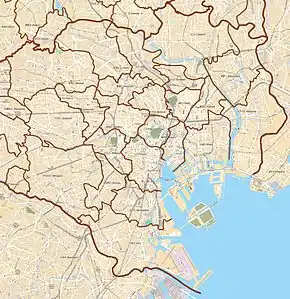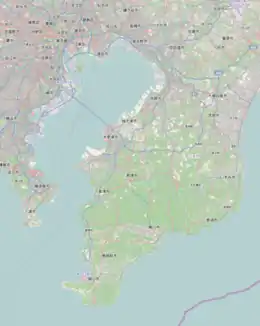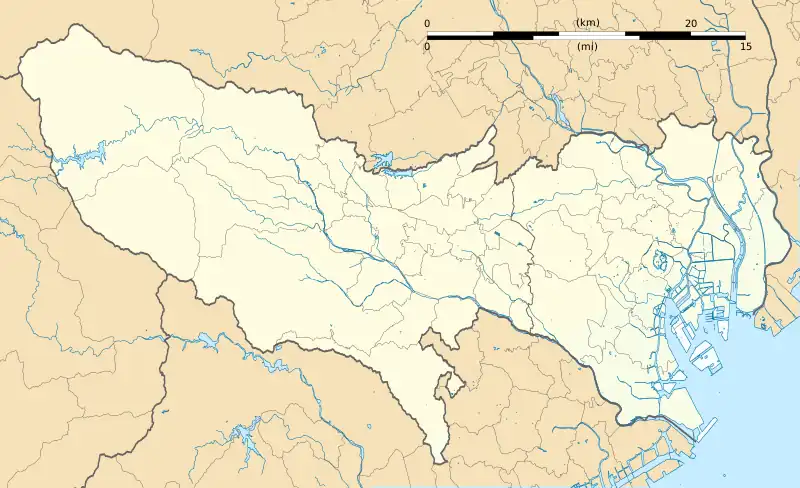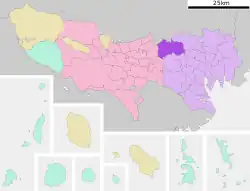Nerima Station
Nerima Station (練馬駅, Nerima-eki) is a railway station in Nerima, Tokyo, Japan, operated by the private railway operator Seibu Railway and the Tokyo subway operator Toei Subway.
SI06 E35 Nerima Station 練馬駅 | ||||||||||||||||||||||||||||||||||||||||||||||||
|---|---|---|---|---|---|---|---|---|---|---|---|---|---|---|---|---|---|---|---|---|---|---|---|---|---|---|---|---|---|---|---|---|---|---|---|---|---|---|---|---|---|---|---|---|---|---|---|---|
 The north entrance in October 2008 | ||||||||||||||||||||||||||||||||||||||||||||||||
| General information | ||||||||||||||||||||||||||||||||||||||||||||||||
| Location | 1-3-5 Nerima, Nerima, Tokyo (東京都練馬区練馬1-3-5) Japan | |||||||||||||||||||||||||||||||||||||||||||||||
| Operated by | ||||||||||||||||||||||||||||||||||||||||||||||||
| Line(s) | ||||||||||||||||||||||||||||||||||||||||||||||||
| Platforms | 3 island platforms (2 for Seibu, 1 for Toei) | |||||||||||||||||||||||||||||||||||||||||||||||
| Tracks | Seibu: 6 (2 non-stopping) Toei: 2 | |||||||||||||||||||||||||||||||||||||||||||||||
| Connections | ||||||||||||||||||||||||||||||||||||||||||||||||
| Construction | ||||||||||||||||||||||||||||||||||||||||||||||||
| Structure type | Elevated (Seibu), Underground (Toei) | |||||||||||||||||||||||||||||||||||||||||||||||
| Other information | ||||||||||||||||||||||||||||||||||||||||||||||||
| Station code | SI06 (Seibu) E-35 (Toei) | |||||||||||||||||||||||||||||||||||||||||||||||
| History | ||||||||||||||||||||||||||||||||||||||||||||||||
| Opened | 15 April 1915 | |||||||||||||||||||||||||||||||||||||||||||||||
| Passengers | ||||||||||||||||||||||||||||||||||||||||||||||||
| Seibu, FY2013, (Toei, FY2012) | 118,601 (Seibu), 35,765 (Toei, boarding only) daily | |||||||||||||||||||||||||||||||||||||||||||||||
| Services | ||||||||||||||||||||||||||||||||||||||||||||||||
| ||||||||||||||||||||||||||||||||||||||||||||||||
| Location | ||||||||||||||||||||||||||||||||||||||||||||||||
 Nerima Station Location within Special wards of Tokyo  Nerima Station Nerima Station (Tokyo Bay and Bōsō Peninsula)  Nerima Station Nerima Station (Tokyo)  Nerima Station Nerima Station (Japan) | ||||||||||||||||||||||||||||||||||||||||||||||||
Lines
Nerima Station is served by the Seibu Ikebukuro Line, Seibu Yurakucho Line, and Seibu Toshima Line, and also by the Toei Ōedo Line subway. It is located 6.0 km (3.7 mi) from the terminus of the Ikebukuro Line at Ikebukuro.[1]
Station layout
Nerima is an elevated station with two island platforms serving four tracks, with an additional outer track on either side used by passing trains.[2] Elevators and escalators connect the platforms to the ticket entrances, and the station contains a waiting room as well.
The Toei station consists of an underground island platform serving two tracks.[2]
Seibu
| 1 | for Tokorozawa, Hannō (from Seibu Yurakucho Line) | |
| 2 | for Tokorozawa, Hannō (from Seibu Ikebukuro Line) | |
| for Toshimaen | ||
| 3 | for Ikebukuro | |
| 4 | for Kotake-mukaihara Y Tokyo Metro Yurakucho Line for Shin-Kiba F Tokyo Metro Fukutoshin Line for Shibuya TY Tokyu Toyoko Line for Yokohama |
 Ticket gates, 2016
Ticket gates, 2016 Platforms, 2016
Platforms, 2016
Toei
| 1 | E Ōedo Line | for Tochōmae, Roppongi, and Daimon |
| 2 | E Ōedo Line | for Hikarigaoka |
 Toei ticket gates, 2016
Toei ticket gates, 2016 Toei Oedo Line underground platforms, December 2019
Toei Oedo Line underground platforms, December 2019
History
The Seibu station opened on 15 April 1915.[1] The Toei station opened on 10 December 1991.[1]
The original ground-level station was rebuilt as an elevated station in 1997, and at the same time, the number of tracks was increased to six to allow non-stop trains to pass.[2]
From 1998, inter-running of some services commenced to and from the Seibu Yurakucho Line.[2]
Station numbering was introduced on all Seibu Railway lines during fiscal 2012, with Nerima Station becoming "SI06".[3]
Through-running to and from Yokohama and Motomachi-Chukagai via the Tokyu Toyoko Line and Minatomirai Line commenced on 16 March 2013.[4]
Passenger statistics
In fiscal 2013, the station was the fourth busiest on the Seibu network with an average of 118,601 passengers daily.[5] In fiscal 2012, the Toei station was used by an average of 35,765 passengers daily (boarding passengers only).[6] The passenger figures for the Seibu station in previous years are as shown below.
| Fiscal year | Daily average |
|---|---|
| 2000 | 70,403[1] |
| 2009 | 100,760[7] |
| 2010 | 109,231[7] |
| 2011 | 109,306[8] |
| 2012 | 113,851[5] |
| 2013 | 118,601[5] |
Cultural references
The station and other parts of the Toei Ōedo Line are referenced in the Digimon Adventure franchise.[9][10][11]
See also
References
- Terada, Hirokazu (July 2002). データブック日本の私鉄 [Databook: Japan's Private Railways]. Japan: Neko Publishing. pp. 201–213. ISBN 4-87366-874-3.
- Kawashima, Ryozo (March 2011). 日本の鉄道 中部ライン 全線・全駅・全配線 第12巻 東京都心北部 [Railways of Japan – Chubu Line – Lines/Stations/Track plans – Vol 12 Northern Central Tokyo]. Japan: Kodansha. p. 31/63. ISBN 978-4-06-270072-6.
- 西武線全駅で駅ナンバリングを導入します [Station numbering to be introduced at all Seibu stations] (PDF). News Release (in Japanese). Japan: Seibu Railway. 23 February 2012. Archived from the original (PDF) on 2015-09-24. Retrieved 10 February 2013.
- 東急東横線・メトロ副都心線相互直通、16日スタート [Tokyu Toyoko Line and Tokyo Metro Fukutoshin Line inter-running to start on 16 March]. Nikkei.com (in Japanese). Japan: Nikkei Inc. 15 March 2013. Retrieved 2 April 2013.
- 駅別乗降人員 2013(平成25)年度 1日平均 [Average daily station usage figures (fiscal 2013)] (PDF) (in Japanese). Japan: Seibu Railway. Archived from the original (PDF) on 14 July 2014. Retrieved 22 June 2014.
- 地下鉄関連情報 [Information in relation to the subway] (in Japanese). Tokyo Metropolitan Bureau of Transportation. Archived from the original on 4 March 2016. Retrieved 22 June 2014.
- 駅別乗降人員 2010(平成22)年度 1日平均 [Average daily station usage figures (fiscal 2010)] (PDF) (in Japanese). Japan: Seibu Railway. Archived from the original (PDF) on 26 June 2011. Retrieved 26 January 2013.
- 駅別乗降人員 2011(平成23)年度 1日平均 [Average daily station usage figures (fiscal 2011)] (PDF) (in Japanese). Japan: Seibu Railway. Archived from the original (PDF) on 1 November 2012. Retrieved 26 January 2013.
- "Odaiba Memorial - Shinjuku". marron.extracaffeine.com. Retrieved 2015-12-15.
- "Odaiba Memorial - Juunigou-sen". marron.extracaffeine.com. Retrieved 2015-12-15.
- "Odaiba Memorial - Hikarigaoka". marron.extracaffeine.com. Retrieved 2015-12-15.
- Rapid Express trains only stop at Nerima when branded as the F Liner service
External links
- Nerima Station information (Seibu Railway) (in Japanese)
- Nerima Station information (Toei) (in Japanese)
